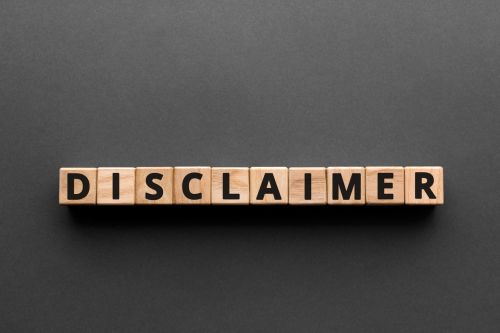The United States Patent and Trademark Office has strict guidelines regarding trademark registration. Critically, there are certain marks — or portions of marks — that cannot be registered because they are not sufficiently distinct. These are marks containing words or designs that are merely descriptive, generic, laudatory, or informational. However, if your trademark contains a word or symbol that does not qualify for protection, you may be able to disclaim that specific component of the overall mark.
What Does a Trademark Disclaimer Do?
A disclaimer is a statement that can be included in a trademark application to indicate you are not seeking exclusive rights to the element of your mark that is un-registrable. For instance, if your company sells hats, it would be denied a trademark on the word “hat” because it merely sets forth a generic description of the goods. But if the mark also contained the company name before the word “hat,” that portion of the mark could be registered (provided it meets the necessary criteria), while the generic word could be disclaimed.
A disclaimer does not affect the appearance of your mark or the way in which it can be used. Specifically, a trademark disclaimer allows an applicant to secure proprietary rights to the distinct portion of the mark, while leaving the descriptive part of the mark open to public use. In other words, by submitting a disclaimer statement, the applicant indicates that they do not have the exclusive right to use that element of the mark when it stands on its own. Rather, the trademark rights exist only in the composite mark.
When is a Disclaimer Necessary?
A trademark disclaimer is required when the words or designs in a mark must be used by other businesses and individuals to describe their goods or services. These statements prevent companies from suing others for trademark infringement over words or symbols that might be necessary for them to use in marketing their products. A few examples of marks that require a disclaimer might include words such as “coffee,” “pizza,” or “shirt.”
Situations in which parts of a mark are unregistrable and require a disclaimer include the following:
- Merely descriptive words or designs — Words or designs used to describe the goods or services being offered generally cannot be registered with the USPTO.
- Laudatory words — Laudatory words used to describe an alleged positive quality of the goods and services being offered, such as “best” or “greatest” usually requires a disclaimer.
- Generic words or designs — Words or designs that identify the product or service, rather than the brand, are considered “generic.”
- Geographic words or designs — Words or designs that describe the geographic origin of goods or services, or the location where they are provided, may require a disclaimer.
- Business type designations — Designations such as “LLC,” “Company,” or “Inc.” will require a disclaimer.
- Informational words — Words that simply provide information about the goods or services must remain open for public use.
- Well-known symbols — Symbols that provide information about your company’s goods or services may require a disclaimer, such as a dollar sign, the recycling symbol, or the prescription symbol.
- Words or designs that are deceptively misdescriptive — If a mark contains words that falsely describe the goods or services and would impact a consumer’s decision to purchase them, may be refused registration
Misspelled versions of words, descriptive or generic foreign words, and compressed compound words that are unregistrable must also be disclaimed. However, if you can show that your trademark is “unitary,” a disclaimer may or may not be required. Unitary words or designs are those that create a commercial impression separate and distinct from any component that would otherwise be unregistrable. Trademark disclaimers can also be avoided if only unique or fanciful words are used in a mark.
How to Write a Trademark Disclaimer
A trademark disclaimer can be included with the original trademark application to the USPTO. Importantly, if it is not submitted at the time of filing, a disclaimer can also be provided by an amendment if required by the examining attorney. If an office action is issued requesting a disclaimer, the USPTO may refuse to register your entire mark if you fail to provide one. In the event a disclaimer was submitted by mistake and would not be required by the USPTO, it may be withdrawn.
Pursuant to the USPTO’s requirements, the language that must be used in a disclaimer statement is as follows: “No claim is made to the exclusive right to use ‘______’ apart from the mark as shown.” While a disclaimed word should appear within quotation marks in the statement, no quotation marks are necessary to disclaim a design. Significantly, an entire mark cannot be disclaimed — only the portion that cannot be protected is subject to a disclaimer statement.
Contact an Experienced Trademark Attorney
Trademark registration can be complex — and it’s best to have the guidance of a skilled trademark attorney who can help ensure your application is filed correctly. Located in Ann Arbor, Michigan, the Trademark Lawyer Law Firm, PLLC assists clients with the trademark registration and application process. Contact us today to schedule a complimentary 15-minute consultation to learn how we can help.





